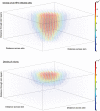The ecology of human papillomavirus-induced epithelial lesions and the role of somatic evolution in their progression
- PMID: 23599315
- PMCID: PMC3698999
- DOI: 10.1093/infdis/jit172
The ecology of human papillomavirus-induced epithelial lesions and the role of somatic evolution in their progression
Abstract
Background: Human papillomavirus (HPV) infection frequently induces hyperproliferation of epithelial cells, leading to both benign (warts) and malignant tumors (cervical cancer). We seek to understand how HPV may achieve these changes by modulating cellular population dynamics. Furthermore, HPV-induced lesion progression is generally understood as a series of molecular changes. As a complement to this approach, we investigate the role of phenotypic changes produced by natural selection during lesion progression.
Methods: We develop and numerically analyze spatially and evolutionarily explicit mathematical models of HPV-induced epithelial lesions.
Results: Infection of basal cells is a requirement for persistent infection. Increasing the maximum tissue density at which HPV-infected cells can divide and decreasing infected cell migration rate leads to large increases in the number of HPV-infected cells, and consequently, virions shed from the skin surface per day. Evolution by natural selection in an autonomous population of cells leads to tissue changes that are qualitatively similar to those observed during lesion progression.
Conclusions: HPV modulates cell population dynamics, which can be characterized by specific ecological parameters. As an unintended consequence, this ecological strategy of the virus may be successfully co-opted by autonomous host cells and play a role in lesion progression.
Keywords: human papillomavirus; partial differential equation model; somatic evolution.
Figures





Similar articles
-
Infection with the oncogenic human papillomavirus type 59 alters protein components of the cornified cell envelope.Virology. 2003 Apr 25;309(1):53-60. doi: 10.1016/s0042-6822(02)00100-9. Virology. 2003. PMID: 12726726
-
The role of human papillomavirus in the malignant transformation of cervix epithelial cells and the importance of vaccination against this virus.Adv Clin Exp Med. 2012 Mar-Apr;21(2):235-44. Adv Clin Exp Med. 2012. PMID: 23214288 Review.
-
Epithelial cell responses to infection with human papillomavirus.Clin Microbiol Rev. 2012 Apr;25(2):215-22. doi: 10.1128/CMR.05028-11. Clin Microbiol Rev. 2012. PMID: 22491770 Free PMC article. Review.
-
Hypothetic association between human papillomavirus infection and breast carcinoma.Med Hypotheses. 2008;70(2):305-7. doi: 10.1016/j.mehy.2007.05.032. Epub 2007 Jul 25. Med Hypotheses. 2008. PMID: 17656036
-
Papillomavirus infections--a major cause of human cancers.Biochim Biophys Acta. 1996 Oct 9;1288(2):F55-78. doi: 10.1016/0304-419x(96)00020-0. Biochim Biophys Acta. 1996. PMID: 8876633 Review.
Cited by
-
Papillomaviruses: Viral evolution, cancer and evolutionary medicine.Evol Med Public Health. 2015 Jan 28;2015(1):32-51. doi: 10.1093/emph/eov003. Evol Med Public Health. 2015. PMID: 25634317 Free PMC article. Review.
-
Mechanistic mathematical models: An underused platform for HPV research.Papillomavirus Res. 2017 Jun;3:46-49. doi: 10.1016/j.pvr.2017.01.004. Epub 2017 Feb 4. Papillomavirus Res. 2017. PMID: 28720456 Free PMC article. Review.
-
A Mathematical Model of Cell Cycle Dysregulation Due to Human Papillomavirus Infection.Bull Math Biol. 2017 Jul;79(7):1564-1585. doi: 10.1007/s11538-017-0299-9. Epub 2017 Jun 12. Bull Math Biol. 2017. PMID: 28608043 Free PMC article.
-
Stochastic modeling of human papillomavirusearly promoter gene regulation.J Theor Biol. 2020 Feb 7;486:110057. doi: 10.1016/j.jtbi.2019.110057. Epub 2019 Oct 28. J Theor Biol. 2020. PMID: 31672406 Free PMC article.
-
Epithelial stratification shapes infection dynamics.PLoS Comput Biol. 2019 Jan 23;15(1):e1006646. doi: 10.1371/journal.pcbi.1006646. eCollection 2019 Jan. PLoS Comput Biol. 2019. PMID: 30673699 Free PMC article.
References
-
- Parkin DM. The global health burden of infection-associated cancers in the year 2002. Int J Cancer. 2006;118:3030–44. - PubMed
-
- Doorbar J. Molecular biology of human papillomavirus infection and cervical cancer. Clin Sci. 2006;110:525–41. - PubMed
-
- Duensing S, Munger K. Mechanisms of genomic instability in human cancer: insights from studies with human papillomavirus oncoproteins. Int J Cancer. 2004;109:167–72. - PubMed
-
- Hudelist G, Manavi M, Pisghinger KID, et al. Physical state and expression of HPV DNA in benign and dysplastic cervical tissue: different levels of viral integration are correlated with lesion grade. Gynecol Oncol. 2004;92:873–80. - PubMed
Publication types
MeSH terms
Grants and funding
LinkOut - more resources
Full Text Sources
Other Literature Sources
Research Materials

